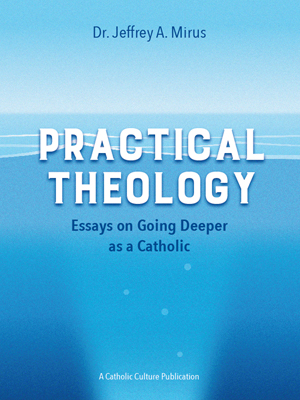The MOST Theological Collection: Catholic Apologetics Today: Answers to Modern Critics
"Chapter 2: Causes of Teenage Doubt"
Although written for the young, others will find this chapter valuable for their own information or to use the data to help a young person who does not have an opportunity to read this.
A strange phenomenon appears in most young people sometime near the end of high school. It starts then, and lasts varying lengths of time-sometimes for years-and is of varying severity.
The symptoms? The young person finds his formerly solid religious beliefs beginning to wobble. He is no longer sure of them; and he is hesitant to ask an older person, for he is definitely inclined not to trust the opinions of any older person. So he is forced to be miserable all by himself, unless of course he talks to others of the same age and finds them in the same quandary, but equally without any way to get out.
We said the length of time this trouble lasts is varying; some never fully emerge from it. That brings us to see the first of the reasons for the problem. When we were children, we simply believed what older people told us. Really, that is all that could be done at an early age. But then as we grow up, we begin to want to know for ourselves, to be able to give a reason for what we believe.
This process is not only quite normal, it can even be a good thing, provided that it is carried all the way to its conclusion. If not, a person may lack stability indefinitely, perhaps for the rest of his life. This process is, then, the normal changeover from the child to the adult pattern of beliefs. It is proper, because adults should not act like children and should be able to give a reason for their beliefs.
No one can be quite comfortable between the shore of childhood belief and the shore of solidly grounded adult faith. For, there one is neither fish nor fowl. He lacks both kinds of security and so he flounders. Eventually he may just give up trying, but yet never achieve the solidity he reasonably wants. Worse, if some great test of faith comes, he may not have the solid basis on which to endure.
Obviously, the rational thing for a young-or even older-person to do in such a quandary is to ask for help from those who are able to give it. Sadly, this is not so often done. First, the young persons are disinclined to think older persons could possibly know anything; second, many older persons never completed the rational process themselves, and are really in no position to help.
There is a second very potent reason for this "at sea" condition. Young people are apt to have their somatic resonance in a state of flux. Somatic resonance is a common term in psychology. It is not hard to understand. A major psychologist of our times, T. V. Moore, told in his last book of a case he met when he was a practicing psychiatrist in Washington, D.C.4 A patient came in for help who suffered from manic-depressive psychosis. He told Dr. Moore he was losing his faith. Moore reports that the man really was not losing his faith; instead, the process of the disease was interfering with his somatic resonance to faith.
Here is the way it works. We are, of course, made up of body and soul, matter and spirit. These elements are so closely joined as to add up to one person. As a result of that union if we have a condition on either side, body or soul, then for smooth running (not for mere survival of the condition) we ought to have a parallel condition on the other side. That parallel is called a resonance. When the resonance is on the side of the body-the more common combination-then it is called somatic resonance, from a Greek word meaning "bodily."
So, then, faith is obviously on the side of the spirit. But faith needs-not for mere survival, but for normal function-a resonance on the bodily side. The process (probably bad biochemistry) of the disease in Moore's patient interfered with the somatic resonance to faith. [The result was that faith was not rejected, but neither could it function normally.] Hence, the poor man thought he was losing his faith.
Now, young people can have a parallel problem. They enter a time of life when there are great bodily changes in the glandular system, especially at the start of sexual functioning. They have not yet had time to learn to live with these changes, to come to terms with them. As a result, their somatic resonance to many things is in a state of flux, so that faith lacks its normal resonance. No wonder faith tends to wobble, to seem to have no foundation.
Obviously, if a young person could only realize what is going on inside him and see that he is being hit by a dramatic changing process, he would be very relieved. We do not say he would quickly find everything easy. But he could step outside himself and see himself objectively. Then at least he would not be so mystified by what he cannot help feeling.
The two conditions we have just explained are clearly part of the process of growing up. As such, they have always affected people, not just in our day. But today, young and old alike are affected by still a third influence: the immense upheaval in the Church and the many claims that everything has changed. It is no wonder many are uncomfortable with their Faith.
So we are going to set out upon a search-to prove that there is help, there is a solid, rational basis for faith.
END NOTES
| 4 | T.V. Moore, Heroic Sanctity and Insanity, Grune & Stratton, N.Y., 1959, p. 102. |






